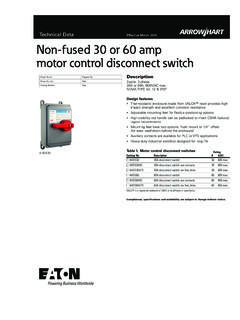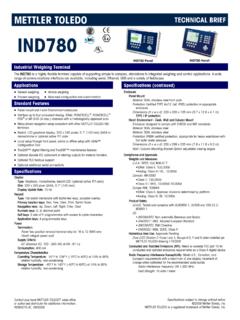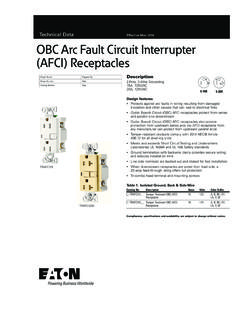Transcription of Common-Mode Rejection: How It Relates to ECG …
1 Technical Article MS-2125.. Common-Mode rejection : Common-Mode rejection , SAFETY, AND RFI. How It Relates to ECG Multiple design trade-offs must be made to optimize Common-Mode rejection in ECG systems. Subsystems and the Evaluating these trade-offs starts with safety. Most standards Techniques Used to Provide indicate that 10 A rms from dc to kHz is the upper limit for normal condition operation of the ECG system. Superior Performance For single fault conditions some standards allow an increase to 50 A rms, but currents as low as 35 A rms can by Bill Crone, Healthcare Systems Engineer, Analog Devices, Inc.
2 Compromise the myocardium. 10 uA rms is recommended for single fault conditions. (See reference 1.). AC mains leakage current must be limited to this maximum IDEA IN BRIEF. level. Various standards measure source and sink currents The techniques described in this article for optimizing between electrodes, electrodes tied together, and with the Common-Mode rejection in ECG subsystems have electrodes energized with ac mains relative to earth ground. been proven over time to result in excellent diagnostic Since standards and specific country directives change with performance, while keeping patient and operator safety time, the designer is encouraged to stay current with latest requirements at the forefront.
3 Releases to ensure continued compliance with safety standards, including maximum source and sink currents allowed, as a function of frequency, for the human subject D. epending on the application for the ECG and the test methodologies used to ensure compliance. subsystem, there are clinical situations where the In addition, the ECG subsystem must be protected from a CMR ( Common-Mode rejection ) must be very defibrillator pulse (bi-phasic or unipolar) so current limit high. The AAMI (Association for the Advancement circuitry is added between the in-amp (instrumentation of Medical Instrumentation) specifies a test methodology amplifier) to protect the circuitry.
4 ESD (electrostatic with typical electrode impedance imbalances and offsets that discharge) protection circuitry is also required. must be met. Other standards, such as IEC, UL, and medical Essential Performance directives from various countries, also have various tests for Common-Mode rejection . In addition to the safety requirements, the ECG subsystem must be able to provide what IEC 60601-1-1 and derivatives This article describes human body impedance mismatch, describe as essential performance during electrosurgical electrode and cable design, protection circuitry, usage of procedures and other harsh environments where nearby RFI.
5 Right leg drive, and other considerations that affect (radio frequency inference) can be high. This would include Common-Mode rejection and proposes various ways to environments such as aircraft, radar, trains, and ships. enhance CMR in ECG subsystems. Sources of Common-Mode Signals The source of a Common-Mode voltage is typically the ac mains frequency of 50 Hz or 60 Hz with line voltages as high as 264 VAC rms. Nontypical environments such as European trains that run off Hz can also be a source of Common-Mode input.
6 Common-Mode Model of the Human Body and Other Circuit Paths of the ECG Subsystem In Figure 2, the Common-Mode signal is coupled through the human torso, from the surface of the skin through the Figure 1. Human Tissue Electrolyte Electrode Model January 2011 | Page 1 of 4 2011 Analog Devices, Inc. All rights reserved. MS-2125 Technical Article Figure 2. Block Diagram of ECG Subsystem. electrolyte, the electrode, to the ECG electrode wire, through defibrillator protection, which typically takes the form of the defibrillator protection circuitry, the RFI input filtering, resistors and SCR/argon voltage limiters, makes common- and in-amp to earth ground through capacitance between mode-to-differential conversion more likely.
7 Isolated ground and earth ground. Figure 1 presents an Tissue/Electrode Issues impedance model of the ECG electrode and its interface to The stratum corneum, the outermost layer of skin, has the the surface of the skin. The ac mains may also be coupled highest impedance component of skin composition to the into the ECG front end through the ECG cable, the input electrode itself and is highly variable at low frequencies and protection circuitry from external transients such as a changes as a function of frequency.
8 The impedance is a defibrillator pulse, and direct coupling through the isolated function of electrode material, size, adhesive, electrolyte power supply. Potential RFI rectification on the in-amp used, and the outer layer/condition of the skin itself. In order input can also create issues with the in-amp Common-Mode to ensure the lowest impedance and more stability in the rejection . electrode interface, some skin preparation techniques use Common-Mode to Differential Mode Conversion sandpaper as a skin prep prior to the placement of the The ac and ECG signals are both measured through the electrode.
9 Various compositions of Ag/AgCl electrodes electrodes into the ECG preamplifier subsystem, making it provide some of the lowest impedances and offsets of other very important to ensure that the Common-Mode signal is commonly used materials. The difference in impedance not converted to differential mode. The combination of between electrodes can be as high as 50,000 over a range mismatches in impedance of the ECG electrodes, cable of frequencies. Reducing this mismatch helps to reduce capacitance, and the protection circuitry associated with Common-Mode -to-differential conversion.
10 (See reference 2.). 2011 Analog Devices, Inc. All rights reserved. January 2011 | Page 2 of 4. Technical Article MS-2125. ECG Cable not the dc portion, higher gains are practical. The trade-offs Some ECG cables embed protection resistors, for are noise performance, dynamic input range, and power defibrillator protection of the circuitry, which can range supply voltage. from k to as high as k electrode. If the resistance DSP Reduces the Common-Mode Signal is not in the cable, then it is typically on the PCB layout.

















